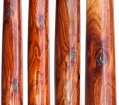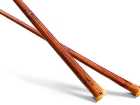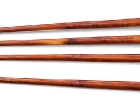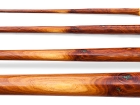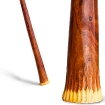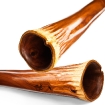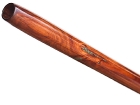|
SHAPE -
LENGTH CLASS
: Fyord INTEGRITY CLASS: Monodidge LENGTH: 242,7cm KEY (DRONE/TOOTS): A//A,F/F#,B,Eb,G#,Bb,C,D,E WOOD: Orkor MOUTHPIECE: inner 30mm, outer 35mm RIM WIDTH: 2,5mm BELL: inner 112mm, outer 135mm, |
LOUDNESS@10CM: average:107dB, max:117dB MASS: 7,4kg FINISH: inner: waterbased polyurethane, outside oil+wax INLAYING: fuchsite BUY DIDGERIDOO: SOLD |
This is one didgeridoo that I have waited for a long time. It is the first one of the super hard wood, and so it is the first one to give us some answers from that kingdom. Since in every description on about basically every product you will hear how fantastic it sounds/looks/drives/smells… I choose to step out of this way of explaining for this didgeridoo. We feel the sound speaks for itself. If you can’t hear it, then it isn’t there for you. If you can hear it, then you understand.
Let me tell you a bit about the making of this didgeridoo. Orkor/Brigalow is very hard and very elastic wood. Has very nice smell. It was difficult to drill, but not as difficult as we imagined. When I started to chisel it, however, I encountered a knot at the bell. And this knot would burst into sharp little pieces, like stone or glass, every time I would hit it with a hammer. This was so brutal to my face that I had to put a mask. At that point I was really again amazed what wood can be. It was very exciting to try every few minutes how sound is changing. In total I really tried many many didgeridoos before I came to this one.
This wood teaches woodworker to be humble. There is no way to rush. Planer needs to go very slowly over it. Sanding machine feels for the first time “broken”. And actually nothing is wrong. It is just another dimension of resistance that wood puts into changing its shape. But it was really surprising to witness the wood that doesn’t feel like sanding that day. Or any other day. The amount of work with this wood is at least double than with normal eucalyptus used for didgeridoo.
The inner geometry of this didgeridoo is more tight than what you could find in recent Duendes. I tried to make something deeper but responsive. I had some instruments we experimented with before, that were shorter and had more texture but I tried to keep the ability to punch and change articulations quickly. Here I could not ask for as much texture (what is texture is my personal sense of 2-5KHz extracted by tongue, voice and lips) because of the length. But the ability for quick changes is here. You should be able to hear it in the sound file. Ro-ko-brisko is quite quite easy and logical to play. It takes a bit of adjusting if you’ve never played an instrument like this, but there are no surprises. There aren’t too many toots. I think I played something like 7 without going into ‘no impedance zone’.
The sound… I really don’t feel I should tell anything about the sound. The only thing I will mention is that for me, it entered my personal sound hall of fame when we recorded it.
The instrument has a very VERY special feeling when you hold it in your hand. Because it is heavy. The grain is so close. Around the knots it creates an inner glow. The surface is polished with wax, and feels impeccable in smoothness. Overall feeling is like holding a didgeridoo of some sort of elastic glass that transmits vibrations well, coloured in uncountable shades of brown, gold, black and yellow…
Hope you enjoy the sound.


